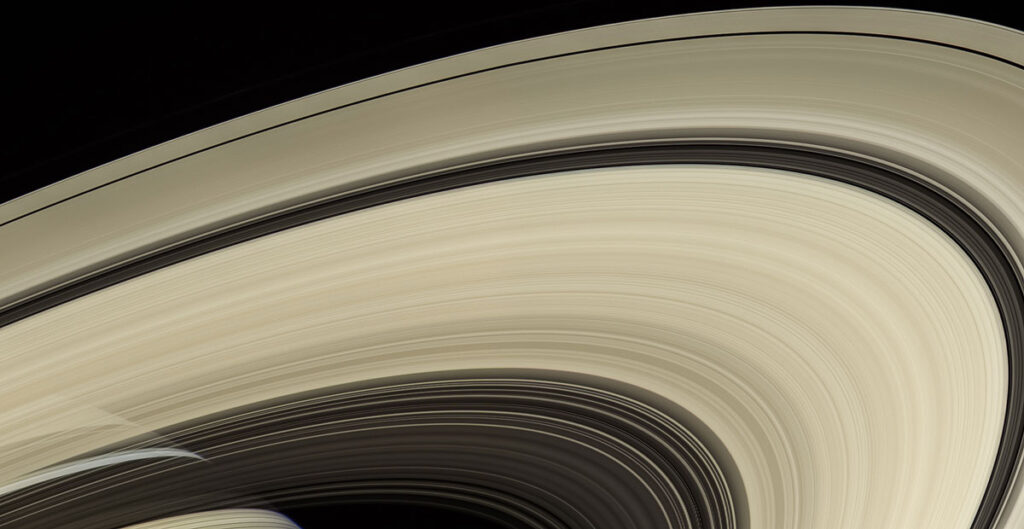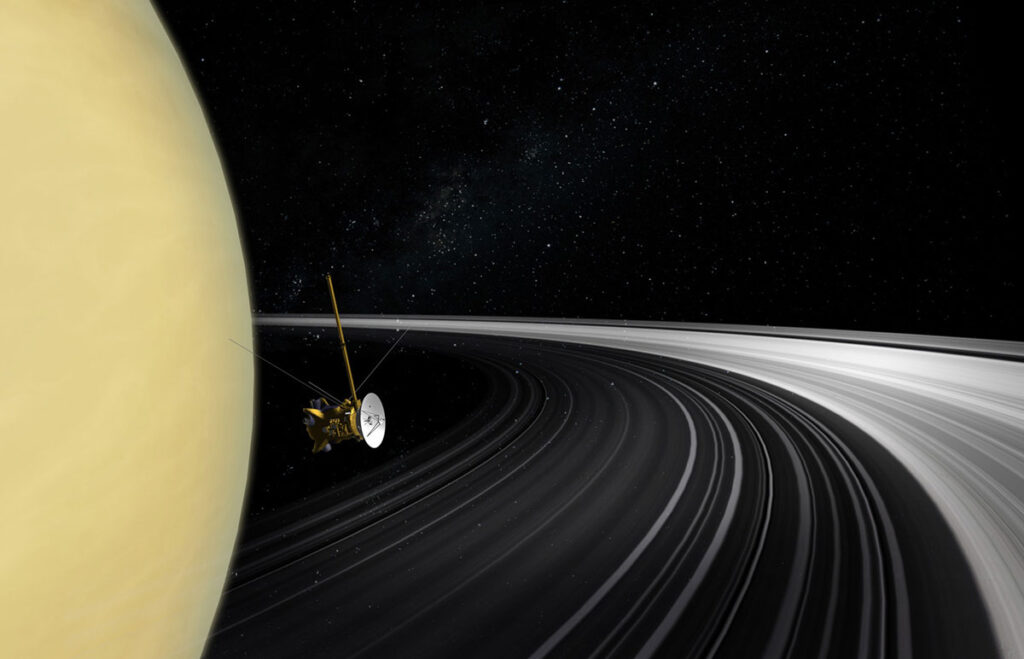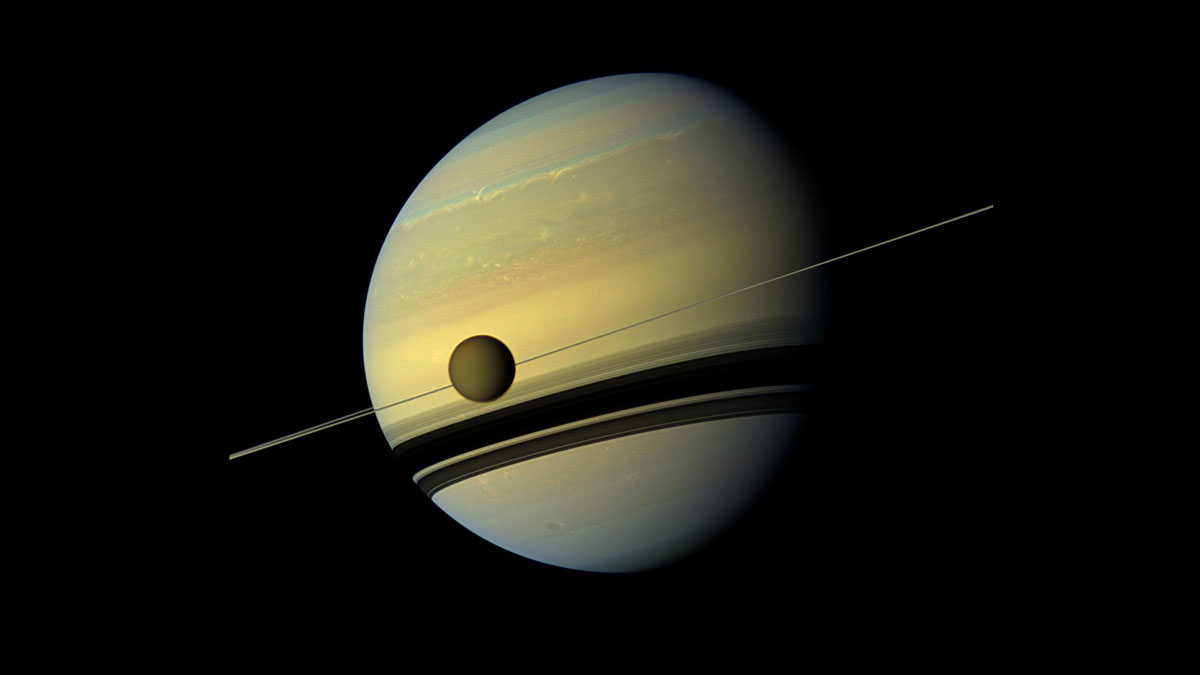A caterpillar emerges from its chrysalis as a butterfly, ready to dazzle the world with its beautiful wings. And according to a recent study in Science, a chrysalis at Saturn underwent its own transformation. Today, the pulverized remains of a small moon—named Chrysalis by the study’s authors—are dazzling the rest of the solar system as the planet’s beautiful rings. The study argues that scenario would explain not only the birth of the rings but Saturn’s tilted axis as well.
“It’s always nice to find solutions that can elegantly explain multiple different observations,” said Tracy Becker, a planetary scientist at the Southwest Research Institute in San Antonio who studies Saturn’s rings but was not involved in the new research. “It could explain Saturn’s obliquity and the age and formation of the rings.”

The project began with Jack Wisdom, a professor of planetary science at the Massachusetts Institute of Technology, and his colleague studying Saturn’s obliquity, or the planet’s tilt on its axis. Saturn and the other giant planets should have developed with a tilt of near zero, yet Saturn tips at an angle of 26.7°.
“Saturn is a massive planet, so it takes a massive force to tilt it like that,” said Burkhard Militzer, a professor of Earth and planetary science at the University of California, Berkeley, and a coauthor of the study. “Jack Wisdom said that even though it’s far, far away, Neptune could do the job.”
A resonance between a wobble in Neptune’s orbit and a wobble in Saturn’s rotation on its axis could have applied enough torque to change the axial tilt. Wisdom and others suggested that Saturn’s largest moon, Titan, could also have played a part in that process.
A Possible Moon Comes to the Rescue
Dynamical simulations show that Saturn and Neptune are not in resonance today. However, “it’s very close—about 1% away,” said Wisdom. “We argued that because it’s so close, it couldn’t have been by chance.”
“At that moment, what had been a problem became a real opportunity.”
“We were always so close” to an explanation, said Militzer, who studies the interiors of Saturn and other outer solar system giants. “It went on for weeks, and it was a big misery. What could get us to the critical value? Then the concept of this moon appeared. At that moment, what had been a problem became a real opportunity.”
“You could add an extra satellite, and that would allow the obliquity to rise due to the resonance with Neptune as Titan migrated outward,” said Wisdom.
Observations from NASA’s Cassini spacecraft, which orbited Saturn from 2004 to 2017, showed that Titan is moving away from Saturn at a rate of about 11 centimeters per year. As Titan migrated outward, it altered Saturn’s axial precession—a wobble that causes the axis to trace a big circle on the sky. Changes in the precession rate brought Saturn and Neptune into resonance. “About a billion years ago, Saturn entered the resonance with Neptune just by the migration of Titan,” Wisdom said.
Simulations showed that the hypothetical moon, Chrysalis, probably orbited between Titan and Iapetus, Saturn’s third-largest moon (though it’s only about a quarter the diameter of Titan). Chrysalis was likely a little less massive than Iapetus, according to the study, and probably consisted mainly of water ice.
As Titan receded from Saturn, it created a 3:1 orbital resonance with Chrysalis, Wisdom said, which increased Saturn’s tilt to as much as 36°.
Chrysalis’s orbit was pumped to a higher and higher eccentricity, drastically altering the smaller satellite’s distance from Saturn and creating closer and closer encounters with Titan and Iapetus.
The Titan-Chrysalis resonance made the moon system chaotic. Chrysalis’s orbit was pumped to a higher and higher eccentricity, drastically altering the smaller satellite’s distance from Saturn and creating closer and closer encounters with Titan and Iapetus. About 100 million years ago, its eccentricity doomed Chrysalis to being kicked out of the Saturn system, causing it to crash into Titan or another moon or bringing it so close to Saturn that it would be ripped apart.
Wisdom’s simulations didn’t necessarily favor any of those scenarios. But one other factor argued for destruction by Saturn: the rings.
As Chrysalis Disintegrates, So Does the Resonance
Scientists have long debated the origin and age of Saturn’s rings. Today, there’s a consensus that they formed from the icy debris of one or more pulverized bodies—small moons or passing comets. There’s less consensus on the age of the rings, however. Some argue that the rings formed not long after Saturn itself. Cassini observations, along with other work, suggest the rings are much younger—perhaps 100 million years or so, matching the time frame for the disintegration of Chrysalis.

“This study predicts the breakup of a moon at around the time a lot of evidence is showing the rings might have been formed and gives a mechanism for how it happened,” said Becker.
According to Wisdom, Chrysalis disintegrated when it passed by Saturn at roughly the same distance as the planet’s diameter. At that range, the side of Chrysalis closer to Saturn faced a stronger gravitational pull than the other side. The difference created powerful tides (just as the Moon creates ocean tides on Earth) that ripped the moon to shreds. Much of its debris fell into Saturn, and the rest spread out over the following hundred thousand years or so to form the rings.
With Chrysalis gone, Saturn’s resonance with Neptune was broken. “Titan is continuing to recede, but as it recedes, the system gets farther from resonance, so [Saturn’s] obliquity is no longer increasing,” Wisdom said. And Saturn retains its magnificent rings, which might have emerged from a long-gone chrysalis.
—Damond Benningfield, Science Writer

